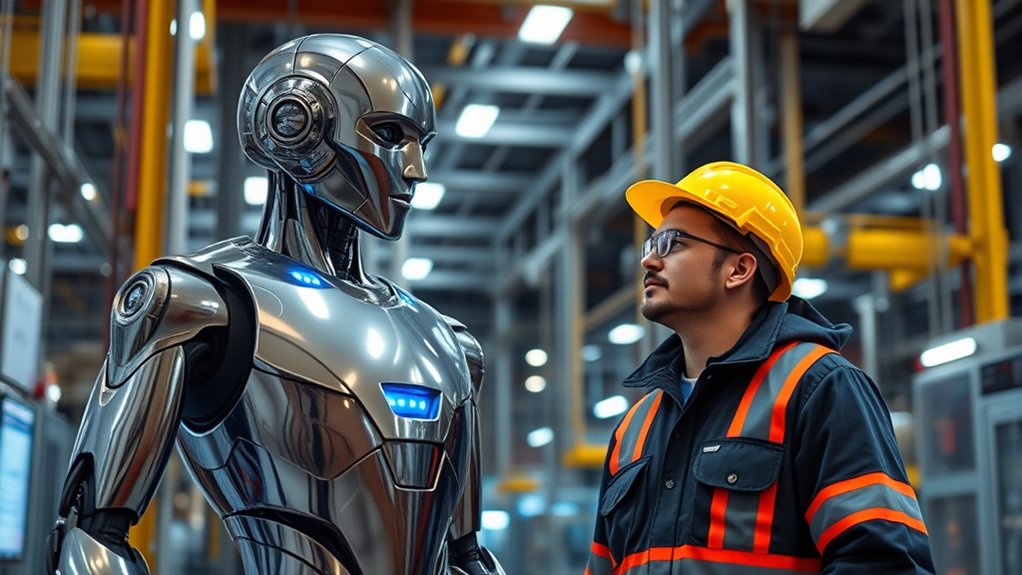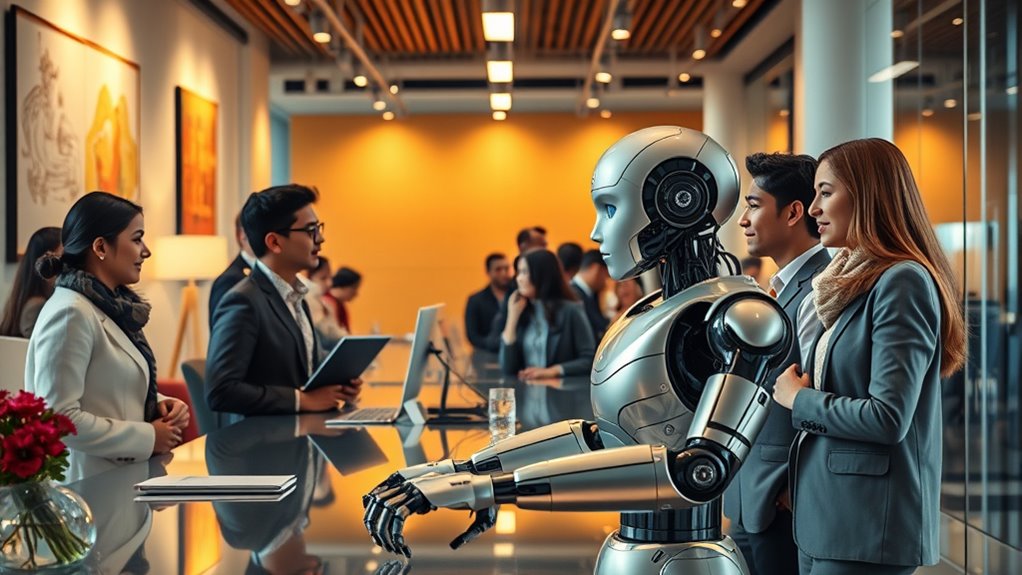While many people are becoming more comfortable working with robots, the desire for a human touch still holds strong—especially across different age groups, cultures, and industries. Younger workers tend to trust AI more easily, but older adults often prefer traditional interactions. Cultural norms and social factors also influence acceptance levels. Although trust in automation is growing, emotional connections and social cues remain essential. If you want to explore how these dynamics shape our future workplaces, keep going.
Key Takeaways
- Older adults tend to prefer human interaction and are cautious about trusting robots, though acceptance increases with familiarity.
- Cultural norms and societal attitudes significantly influence acceptance, with countries like Japan showing more positive robot integration.
- Trust in robot workers is rising, especially for routine tasks, but concerns about job displacement and social connection persist.
- Human-like appearance and respectful communication from robots enhance acceptance, though overly realistic designs risk discomfort (uncanny valley).
- Industry-specific needs and perceptions shape acceptance, with sectors like manufacturing balancing efficiency gains against fears of human job loss.
Changing Attitudes Toward Automation Across Age Groups

How have attitudes toward automation shifted across different age groups? Older adults, especially those over 50, tend to believe automation has hurt workers and are less familiar with AI. They often see automation as a threat to jobs and prefer traditional work environments. In contrast, younger workers, like those aged 18-24, have experienced more personal impacts from automation, such as job losses, and are more open to trusting AI for positive experiences. Support for policies limiting automation is common across all ages, but younger generations are generally more comfortable using AI for routine tasks like scheduling and data analysis. Despite differences, most age groups view AI positively, though older workers are slightly more cautious. Attitudes toward automation evolve as familiarity and personal experience grow across generations, especially as exposure to technological advancements increases. Furthermore, the level of digital literacy plays a crucial role in shaping perceptions across age groups, influencing how readily individuals accept automation in their daily lives. As automation becomes more integrated into daily activities, perceptions are likely to shift further, especially with ongoing improvements in AI integration and user-friendly interfaces. Recognizing the importance of home improvement and organizational skills can also facilitate smoother transitions to automated solutions in various environments.
The Role of Human-Like Interaction in Robot Acceptance

Attitudes toward automation are greatly influenced by how humans perceive and interact with robots. A robot’s appearance plays a crucial role in initial acceptance; more human-like features often create positive first impressions, especially when combined with polite communication. However, appearance alone isn’t enough—behavior matters equally. Polite, considerate interactions boost ongoing acceptance, building trust and rapport. If a robot fails to communicate respectfully, acceptance can decline, even if it looks appealing. Emotional connection also influences long-term acceptance, as robots that foster social bonds and understanding tend to be more trusted and accepted. Research shows that human perception can discriminate between human and artificial movements, influenced by observation modality. Yet, overly human-like robots risk discomfort or rejection due to the uncanny valley effect. Balancing human likeness with functional clarity and respectful interaction is key to promoting positive, lasting acceptance of robot workers.
Industry-Specific Perspectives on Robot Integration

Industries adopt robotic integration based on their unique operational demands and technological needs. In manufacturing, automation boosts productivity by up to 30% but risks displacing 20 million jobs by 2030. The electronics sector relies heavily on robots for precision, with 28% of new installations globally, especially in Asia. The automotive industry uses robots to improve efficiency and cut costs, with countries like Korea leading the way.
| Industry | Key Focus |
|---|---|
| Manufacturing | High productivity, job displacement concerns |
| Electronics | Precision, advanced vision-guided robots |
| Automotive | Efficiency, AI integration |
The Impact of Job Displacement Concerns on Public Perception

Your worries about losing your job to automation can shape how you view robot workers. When displacement fears grow, trust in these technologies tends to decline, fueling skepticism. Understanding these concerns is vital to steering public acceptance of robotic automation. Current impact is more restrained compared to future projections, which may influence how immediate these fears feel to workers today. Additionally, the evolving cyber threat landscape underscores the importance of human judgment in decision-making processes that AI cannot fully replicate. As automation advances, the vetted Halloween product reviews highlight how consumer perception can fluctuate based on safety and authenticity concerns, which also impact acceptance of new technologies. Moreover, concerns about credit card security often influence public confidence in automated payment systems, affecting their overall acceptance. Recognizing how public perception varies based on safety, trust, and authenticity is essential for understanding broader acceptance challenges. Furthermore, the trust in human judgment remains a critical factor in how society adapts to these technological changes, emphasizing that not all decisions can or should be automated.
Anxiety Over Automation
As automation technology advances rapidly, many workers worry that their jobs may soon disappear or become less secure. About 30% fear AI will replace their roles by 2025. Younger workers, especially those aged 18-24, are 129% more likely to worry about obsolescence than older generations. Those who have already experienced displacement show even higher anxiety, with 47% fearing job loss compared to 29% of unaffected workers. This fear stems from the fast pace of change and uncertainty about future skills needed. Some employees, however, remain hopeful; around 15% in the US are open to AI acting as a supervisor. Overall, widespread concern influences public perception, fueling skepticism and impacting how automation is adopted and accepted in workplaces. Widespread automation could affect 1.2 billion employees and impact $14.6 trillion in wages, which underscores the gravity of these anxieties. Additionally, the rapid evolution of robotic automation amplifies these fears, as many are unsure whether new technologies will complement or replace human workers.
Shifts in Workforce Trust
Despite widespread concerns about job displacement, most employees trust automation solutions to deliver accurate results, with almost 9 in 10 believing they reduce errors. You may think that automation threatens jobs, but 54% of HR professionals see it as a tool to focus on more important tasks rather than a threat to employment. Additionally, 40% of companies using HR automation report it helps reduce bias, and 36% believe it improves onboarding. Small business owners also see automation as a way to stay competitive, with 88% saying it helps level the playing field. Overall, trust in automation’s precision and efficiency is growing, even as concerns about displacement persist. This shift indicates that many see automation as an asset rather than a risk, shaping future workforce dynamics. For example, Self Watering Plant Pots utilize a reservoir system that allows plants to absorb water as needed, which demonstrates how automation can streamline tasks and improve outcomes. Furthermore, understanding the ethical considerations involved in deploying automation helps foster greater public acceptance and confidence. Recognizing the impact of visionary ideas on technological advancement can inspire confidence in automation’s potential to enhance our lives. Additionally, innovations like Kia Tuning exemplify how automation and customization can optimize vehicle performance and meet individual preferences. As the integration of automation deepens, it can also influence mental health by reducing stress associated with repetitive tasks and decision fatigue, fostering a healthier work environment.
The Influence of Cultural Factors on Acceptance Levels

Cultural factors play a crucial role in shaping how people accept and interact with service robots. Your cultural background influences attitudes, with countries like Japan, known for robotics, showing more positive acceptance. Social norms also matter—what’s customary in one culture might hinder robot integration in another, especially with respect to human relationships emphasized by philosophies like Ubuntu. Language and communication styles impact interactions, affecting comfort levels with robots. Power distance influences trust; cultures with high power distance may view robots as threats to authority, reducing acceptance. Conversely, cultures with high uncertainty avoidance often embrace robots that ease anxiety. Media exposure and cultural representation shape perceptions, while personal experiences and societal norms dictate how well robots meet expectations, ultimately influencing their acceptance across different cultural landscapes. Additionally, the ongoing development of AI Security measures can influence public trust and confidence in robotic technologies. Moreover, fostering cultural intelligence within organizations can enhance the implementation and acceptance of robotic solutions by aligning technological integration with local norms and values. Recognizing the importance of cultural heritage can also help tailor robotic interactions to be more respectful and aligned with societal expectations.
Psychological and Social Effects of Working Alongside Robots

Working alongside robots can affect your trust and comfort levels at work, making you feel more anxious or uncertain. As robots take on roles that once involved human interaction, interpersonal dynamics may shift, leading to feelings of distrust or competition. Understanding how these changes influence your psychological well-being is essential for creating a positive work environment. Incorporating voiceover skills into human-robot interactions can also improve communication and ease tensions. Additionally, recognizing the importance of public health initiatives in workplace settings can help address these psychological challenges effectively. Regular list cleaning of employee data can also improve overall workplace trust and engagement, fostering a healthier environment. Furthermore, fostering transparency about AI capabilities and limitations can help mitigate trust issues and promote a more collaborative atmosphere. Being aware of beginners guides related to workplace technology can also help employees adapt more smoothly to these changes.
Trust and Comfort Levels
As robots become more integrated into workplaces, trust and comfort levels among workers are evolving rapidly. You might find yourself trusting robots more than human managers for advice, as 64% of workers already do. Many believe robot managers excel at tasks like scheduling and providing unbiased information, with 82% recognizing their strengths. An impressive 93% are willing to follow robot orders at work, especially in regions like China and India where trust is higher. Workers across countries report feeling increasingly comfortable working alongside AI, driven by perceptions of efficiency and fairness. This shift affects how you perceive authority and your psychological comfort. As robots become more common, your acceptance grows, shaped by cultural factors and the perception of robots as impartial and effective colleagues. Additionally, the psychological and social effects of working alongside robots influence how individuals adapt to this new environment. The rise of virtual collaboration platforms in hackathons exemplifies how digital environments facilitate teamwork with diverse, geographically dispersed participants. Moreover, understanding the volatility risks associated with emerging AI-driven workplaces is crucial for maintaining stability and confidence in these new arrangements.
Interpersonal Dynamics Shift
The integration of robots into the workplace is reshaping interpersonal dynamics, often impacting your psychological well-being and social interactions. You may feel insecure about your job as robots take on more tasks, leading to stress, burnout, and workplace incivility. This environment can increase anxiety and negatively affect your mental health, sometimes even contributing to substance misuse in highly automated areas. Socially, working alongside robots might reduce your interactions with colleagues, fostering feelings of isolation and weakening team cohesion. As automation advances, skills may become obsolete, diminishing your sense of purpose and decreasing job satisfaction. These changes also influence workplace culture and societal perceptions, creating a complex web of psychological and social effects that challenge traditional human-centered work environments.
Future Trends in Human-Robot Collaboration and Trust

Advancements in robotics are shaping a future where human-robot collaboration becomes more seamless and trustworthy. Cobots now safely work alongside humans, taking on repetitive and hazardous tasks while adapting through AI, sensors, and machine learning. Features like collision detection and force sensing boost safety and efficiency. Integration with IIoT enables optimized workflows and data-driven decisions, addressing labor shortages and augmenting human roles. Digital twin technology allows real-time simulation and predictive maintenance, reducing downtime and accelerating innovation. Humanoid robots with enhanced mobility and AI-driven adaptability serve in healthcare, industrial inspection, and personal assistance, building more relatable interactions. Modular, customizable robots fit seamlessly into existing workflows, increasing flexibility. These trends foster trust by emphasizing reliability, transparency, and predictability, paving the way for more collaborative and human-centric workplaces.
Frequently Asked Questions
How Do Economic Incentives Influence Acceptance of Robot Workers?
Economic incentives shape how you view robot workers by highlighting their productivity and cost benefits, which can lead to increased acceptance. When companies boost efficiency and competitiveness with robots, you might see them as helpful tools rather than threats. However, wage impacts and job displacement concerns could foster resistance. Ultimately, if policies support retraining and job transitions, you’ll likely feel more positive about integrating robots into workplaces.
What Ethical Considerations Arise From Replacing Humans With Robots?
When considering replacing humans with robots, you must think about ethical issues like job displacement, safety, privacy, and dignity. You might worry about how automation affects workers’ mental health, data security, and social interactions. It’s essential to balance technological progress with moral responsibility, ensuring robots complement human roles without causing harm or devaluing human work. Prioritizing transparency, fairness, and respect helps navigate these ethical challenges effectively.
How Do Small Businesses View Robot Integration Versus Large Corporations?
You see that small businesses embrace robot integration for its affordability and simplicity, often using leasing models to avoid hefty costs. They focus on cobots that are easy to set up and pay back within a few years. In contrast, large corporations have the resources to purchase and deploy more complex robots at scale, aiming to boost efficiency across many departments. Both recognize automation’s benefits, but their approaches differ based on size and capacity.
What Role Does Government Policy Play in Robot Workforce Adoption?
You might think government policies have little impact on robot adoption, but they actually play a key role. Policies like tax breaks, subsidies, and research funding lower costs and encourage businesses to integrate robots. They also support workforce training, helping workers adapt. By shaping regulations and offering incentives, governments accelerate automation, making it more accessible and beneficial for industries, ultimately boosting productivity and economic growth.
How Might Advancements in AI Impact Human Trust in Robots?
Advancements in AI can boost your trust in robots when they improve responsiveness, competence, and social presence. As you gain direct experience interacting with AI, your confidence grows, especially if the robot behaves reliably and adapts to your needs. However, over-reliance might make you overly trusting, risking mistakes. Cultural and personal differences also shape your trust, so acceptance varies depending on how well AI aligns with your expectations and experiences.
Conclusion
Imagine walking a tightrope between tradition and innovation, balancing your trust on a slender wire. As robots become your new partners, your grip tightens with familiarity, yet your heart still yearns for the human touch. The journey ahead is like sailing uncharted waters—trust and acceptance will be your compass. Together, humans and robots can navigate this evolving landscape, forging a future where harmony guides every step you take.









